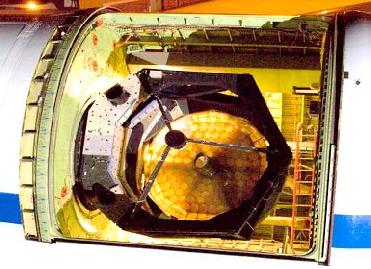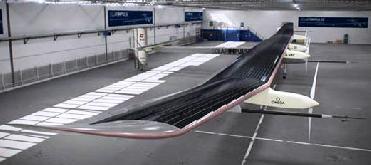
The SOFIA telescope mounted in the rear fuselage of Boeing 747SP aircraft. Image Credit: NASA.
NASA's Stratospheric Observatory for Infrared Astronomy - or SOFIA is a world-class airborne observatory which will complement the likes of Hubble, Herschel, James Webb and other such major space telescopes.
SOFIA is a Boeing 747SP aircraft housing a 2.5‐meter gyrostabilised telescope designed to make sensitive measurements of a wide range of astronomical objects at wavelengths from 0.3 μm to 1.6 mm.
It is a joint programme between NASA and DLR Deutsches Zentrum fur Luft- und Raumfahrt (German Aerospace Center). It is the world's biggest, most advanced airborne observatory.
SOFIA's 2.5-meter infrared telescope is a German built and weighs around 20 tons. The telescope is mounted in the rear fuselage of Boeing 747SP aircraft.
The Boeing 747SP is a highly modified commercial airliner. It has a longer range and an increasing speed. The installation of the telescope and the aircraft modifications has carried out L-3 Communications Integrated Systems facility.
SOFIA is a mobile observatory whose flexibility makes it comfortable to move in any position to capture especially interesting astronomical events such as stellar occultations.
SOFIA MISSION
SOFIA will provide astronomers with access to the visible, infrared and sub-millimeter spectrum, with optimised performance in the mid-infrared to sub-millimeter range. It will be the only infrared mission allowing observations of the inner planets and comets when they are brightest and most active.
Aboard SOFIA astronomers will conduct comprehensive investigations of diverse cosmic environments, collecting data for understanding all parts of the great story of the structure and evolution of the universe.
The mission will be conducted over virtually the entire globe. SOFIA will be flown at altitudes of 39,000 to 45,000 feet, above 99 percent of the water vapor in the lower atmosphere.
SOFIA, in full operation, will be capable of making more than about 100 8‐10 hour scientific flights per year. It will provide three times better image quality and highly increased observational sensitivity. It will begin operations in 2010.
First-generation science instruments will be installed for the SOFIA mission. They are;
- HAWC High-resolution Airborne Wideband Camera
- EXES Echelon-Cross -Echelle Spectrograph
- FIFI LS Field Imaging Far-Infrared Line Spectrometer
- FORCAST Faint Object InfraRed CAmera for the SOFIA Telescope
- CASIMIR C Altech Submillimeter Interstellar Medium Investigations Receiver
- GREAT German Receiver for Astronomy at Terahetz Frequencies
- FLITECAM First Light Infrared Test Experiment CAMera
- SAFIRE Submillimeter And Far InfraRed Experiment
- HIPO High-speed Imaging Photometer for Occultation
- GUIDERS Guider cameras
- WV MONITOR Water Vapor Monitor
Such wide range of instruments will facilitate a coordinated science programme through analysis of specific targets. With their help SOFIA will help answer many fundamental questions about the creation and evolution of the universe, including how stars and planets are formed.
SOFIA will be an ideal platform for new technologies and a learning ground for the young students, scientists and astronomers. It will educate them in instrument hardware and software development.
The SOFIA programme is managed by NASA's Dryden Flight Research Center, Edwards, California. The aircraft, Boeing 747SP is based at the Dryden Aircraft Operations Facility, Palmdale, California. NASA's Ames Research Center manages the SOFIA science and mission operations in cooperation with the Universities Space Research Association, Columbia, and the Deutsches SOFIA Institute, Stuttgart, Germany.
- Courtesy:
NASA
SOFIA Science Center
 Previous Article
Previous Article Next Article
Next Article












The Indian Air Force, in its flight trials evaluation report submitted before the Defence Ministry l..
view articleAn insight into the Medium Multi-Role Combat Aircraft competition...
view articleSky enthusiasts can now spot the International Space Station (ISS) commanded by Indian-American astr..
view article